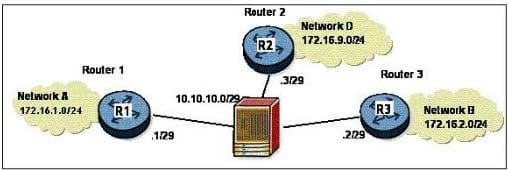Exam Details
Exam Code
:4A0-100Exam Name
:Nokia IP Networks and Services FundamentalsCertification
:Nokia CertificationsVendor
:NokiaTotal Questions
:352 Q&AsLast Updated
:Apr 11, 2025
Nokia Nokia Certifications 4A0-100 Questions & Answers
-
Question 131:
TCP is sending data in 5 segments with SEQ numbers 27000, 27500.28000, 28500, and 29000 respectively. During transmission, the segment with SEQ=28500 is dropped in the network. How does TCP handle this situation?
A. The receiving end station sends an ACK flag with SEQ=28000 to indicate it has received a segment out of order.
B. The receiving station sends a NACK frame with SEQ=28500 requesting that the frame be retransmitted
C. Once the reciever's window is full. TCP assembles the payload and determines that SEQ=28500 is missing. At this point, the reciever sends the RST flag with SEQ=28500 to Request Single Transmission of the missing segment.
D. TCP will collect the segments and forward them to the application layer where the SEQ numbers will be processed and a retransmit request will occur for the entire packet.
-
Question 132:
Which field in the TCP header is used by the receiver to indicate the number of segments it can receive?
A. Checksum
B. SYN
C. Destination port
D. Window size
E. MTU
-
Question 133:
What is the function of a Routing Table Manager (RTM)?
A. To find the best path to the destination network and install it in the routing table - based on the metrics of the routing protocol.
B. To provide a CLI interface that allows the operator to configure the dynamic routing protocol on the router.
C. To choose the route with the lowest preference and install it in the routing table - based on the routing protocol preference values.
D. To provide a CLI interface that allows the network operator to install static routes in the routing table.
-
Question 134:
What must occur before a LAG becomes operational?
A. There must be multiple ports assigned to the LAG.
B. All ports in the LAG must be configured with the same speed and duplex settings.
C. Auto-negotiation must be enabled on all ports in the LAG.
D. The duplex setting on all the ports must be forced to half.
E. Auto-negotiation must be set to limited or disabled on at least one member port.
-
Question 135:
Which of the following statements are TRUE regarding IP-filters? (Choose 2)
A. IP-filters may be applied on interface ingress, egress, or both.
B. Multiple IP-filters can be applied in each direction.
C. An IP-filter may only be applied to a single interface if the scope is set to template.
D. An IP-filter may have multiple match criteria per entry.
E. The default-action of an IP-filter is always drop.
-
Question 136:
Which of the following are correct statements about MPLS labels? (Choose 3)
A. A sequence of label actions from one LER to another LER represents a logical tunnel known as an LSP.
B. MPLS labels must be dynamically signaled.
C. Labels are globally significant to the MPLS network.
D. MPLS labels may be dynamically signaled or statically assigned by the service provider.
E. Labels are locally significant to the MPLS router.
-
Question 137:
Which of the following statements best describe the purpose of UDP? (Choose two)
A. Provides a connectionless delivery service.
B. Provides a connection oriented delivery service
C. Provides an unreliable transmission service,
D. Provides a reliable transmission service.
-
Question 138:
Based on the network diagram (click the Exhibit Button). Router 1 installs network D in its routing table following a dynamic routing update from Router 2. Which of the following describes the information that will be installed in the routing table?

A. 172.16.9.0/24 next-hop 10.10.10.1
B. 172.16.9.0/24 next-hop 10.10.10.2
C. 172.16.9.0.24 next-hop 10.10 10 3
D. 0.0.0.0/32 next-hop 172.16.9.1
-
Question 139:
Which of the following statements best characterize Link State Routing? (Choose 2)
A. Routers periodically send a copy of their routing table to their neighbors.
B. Routers flood link information throughout the entire area.
C. Network converges quickly (within several seconds) after a topology change.
D. Routers do not have precise knowledge of the entire network topology.
-
Question 140:
How is Ethernet II different from Ethernet 802.3?
A. Ethernet II can be used on broadcast networks where as 802.3 was designed for point-to-point networks.
B. Ethernet II identifies its payload type where as 802.3 indicates the frame length.
C. Ethernet II identifies its frame length while 802.3 indicates the payload type.
D. Ethernet II and Ethernet 802.3 are two different names for the same protocol.
Related Exams:
4A0-100
Nokia IP Networks and Services Fundamentals4A0-101
Nokia Interior Routing Protocols4A0-102
Nokia Border Gateway Protocol for Internet Routing4A0-103
Nokia Multiprotocol Label Switching4A0-104
Nokia Services Architecture4A0-105
Nokia Virtual Private LAN Services4A0-106
Nokia Virtual Private Routed Networks4A0-107
Nokia Quality of Service4A0-108
Nokia Multicast Protocols4A0-109
Alcatel-Lucent Triple Play Services
Tips on How to Prepare for the Exams
Nowadays, the certification exams become more and more important and required by more and more enterprises when applying for a job. But how to prepare for the exam effectively? How to prepare for the exam in a short time with less efforts? How to get a ideal result and how to find the most reliable resources? Here on Vcedump.com, you will find all the answers. Vcedump.com provide not only Nokia exam questions, answers and explanations but also complete assistance on your exam preparation and certification application. If you are confused on your 4A0-100 exam preparations and Nokia certification application, do not hesitate to visit our Vcedump.com to find your solutions here.